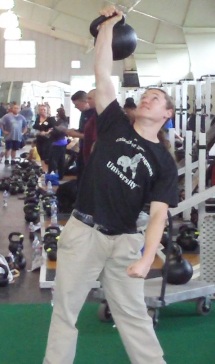Almost another month has passed since I last wrote about biofeedback training. I’ve decided I want to give a play by play account of how it’s working out for me. That means this will be the first in a series of articles on my progress in biofeedback training. And for this one I have to go back in time a bit to when I started.

Any and all movements can be tested.
When I first heard the idea of biofeedback for physical training I was intrigued. It made sense to me, that our own body could guide what we do. Our goal is to make the body better, to build a better mind-muscle connection in order to become stronger. If you had a way to ask your body what it preferred it to do, what was good for it to do, it makes sense then that you should listen to it, at least to me.
I got started testing out my exercises. A little later I tested the weights I was using.
For the most part, early on I ignored the testing and then had to struggle to set a new PR. Sometimes I made it, sometimes I didn’t. What I was doing was following my old routine just testing to see how the movements tested. Then I did my routine regardless of the results. That’s not how you’re suppose to do it. But it was my first step.
The testing was awkward. In a range of motion test you’re suppose to go until you feel tension. Sounds good in theory. But when you first try it you may not be the best at feeling the first sign of tension. I know I wasn’t. In order to help me out I decided to do two different ROM tests each time to see that they were giving the same results.
I continued on. I figured that I would give this method at least a month to start showing results. If it didn’t I could jump back into my routines. I started actually listening to the tests. I finally dropped the idea that I needed to known exactly what I was going to be doing when I entered the gym. I would let the tests guide me to do what I should be doing.
It took a couple weeks before I felt that I was getting it right. At that time I was testing exercises, variations, loads and rest. It started coming together and I was seeing myself hit new PR’s without struggling for them.
Of course, the testing (and moving into a new place) led me to be doing different exercises and different volumes so it wasn’t hard to be hitting PR’s. Anytime you start new exercises there is a period of time were your body adapts quickly becoming more efficient at the exercises. You become better at the exercises rather than building much strength or muscle to do the exercises.
That’s why I always encouraged sticking to a routine. You need to work the same exercises over a period of time in order to see real improvements. If you jump from routine to routine you aren’t doing much more than spinning your wheels.
This isn’t really in contrast to biofeedback training though. You still have your goals. If that involves being able to deadlift more you’ll aim your testing in the direction. Unless your body is messed up and dead lifting is not right for you you’ll be able to continually work the lift and do more.
More on this subject real soon.
In strength,
Logan Christopher


Comments
Hey,
I was wondering how would you tests the amount of sets and reps you’re suppose to use?(not in what way ie. toe touch but how do you know if 3 reps is better than 10 reps if they both test equally well)
Thanks,
Alan
@Alan: For reps you’re suppose to stop before tension, change of breathing, or loss of speed. If two things are testing equally well then its your pick.
Pingback: Progress in Biofeedback Training - Part 2Legendary Strength